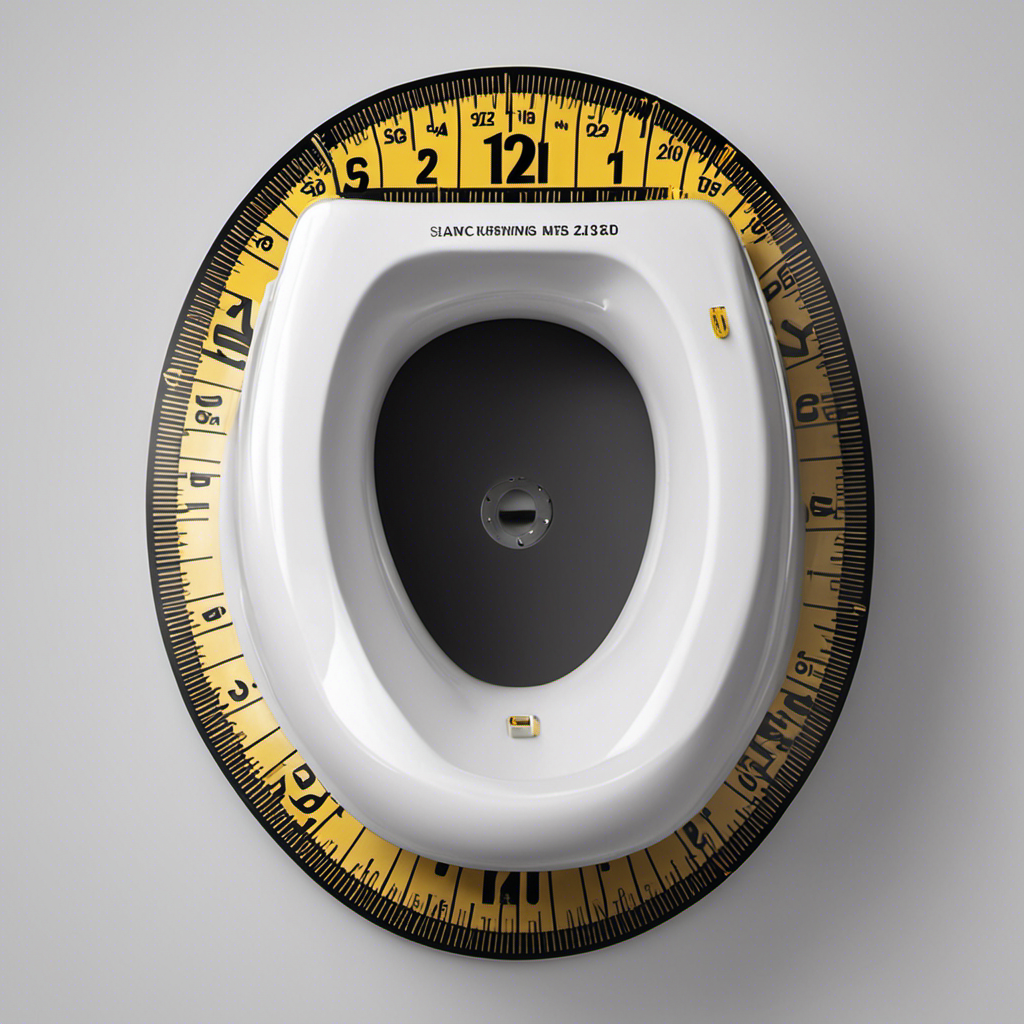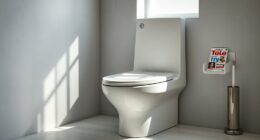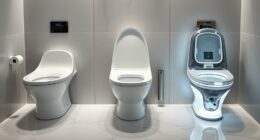I know what you’re thinking – measuring a toilet seat size may not sound like the most exciting task in the world. But trust me, it’s an essential one. Whether you’re replacing an old seat or simply want to ensure the perfect fit, getting the measurements right is crucial.
In this article, I’ll guide you through the step-by-step process of measuring the length, width, bolt hole spacing, shape, and thickness of a toilet seat. So, let’s dive in and become toilet seat measuring experts!
Key Takeaways
- Accurate measurements are essential for a proper fit and installation of the toilet seat.
- Measuring from the center of the mounting holes and considering the shape of the seat are important factors to avoid common mistakes.
- Different toilets may have varying bolt hole spacing, so measuring each toilet individually is necessary.
- Choosing the right width, shape, and thickness of the toilet seat is crucial for proper positioning, matching bathroom decor, and ensuring comfort and durability.
Measuring the Length of the Toilet Seat
To measure the length of the toilet seat, you’ll need a tape measure. It is crucial to take accurate measurements when replacing a toilet seat to ensure a proper fit.
Common mistakes when measuring toilet seat size include not measuring from the center of the mounting holes and not accounting for the shape of the seat.
Start by placing the tape measure at the center of one mounting hole and stretch it across to the center of the other hole. Make sure to measure the length from the front edge of the seat to the back edge.
Understanding the importance of accurate measurements for toilet seat replacement will help avoid purchasing the wrong size and save you from the hassle of returning or exchanging the product.
Determining the Width of the Toilet Seat
Determining the width of the toilet seat can be done by simply measuring its side to side distance. To ensure proper positioning and find the right fit for your bathroom decor, consider the following:
- Measure the distance between the two outer edges of the seat, also known as the width.
- Use a measuring tape or ruler for accurate measurements.
- Take note of any additional features, such as hinges or bumpers, that may affect the width.
- Consider the shape of the toilet bowl when choosing a seat, as different shapes may require different widths.
Measuring the Bolt Hole Spacing
Once you’ve got the width of the toilet seat sorted, it’s time to measure the bolt hole spacing for a secure installation. To ensure a proper fit, it is crucial to measure the distance between the bolt holes accurately.
Start by locating the bolt holes on the toilet bowl rim. Using a tape measure, measure the distance between the centers of the two bolt holes. This measurement will determine the bolt hole spacing required for your new toilet seat.
It is important to note that different toilets may have varying bolt hole spacing, so it is essential to measure each toilet individually.
Additionally, while measuring the toilet seat, it is also crucial to determine the material it is made of. This will help in selecting the appropriate cleaning products and ensure proper maintenance.
Determining the Shape of the Toilet Seat
When choosing a new toilet seat, you should consider the shape that will provide the most comfort for you. There are different types of toilet seat shapes available in the market, each offering unique benefits.
Here are some factors to consider when choosing a toilet seat shape:
-
Round: This shape is compact and ideal for smaller bathrooms. It provides a comfortable seating experience for most users.
-
Elongated: Elongated toilet seats offer more surface area for sitting and are preferred by individuals who value extra space and comfort.
-
Square: Square-shaped toilet seats are modern and stylish, adding a contemporary touch to your bathroom decor.
-
D-shaped: D-shaped toilet seats have a flat back and a curved front, providing a sleek and ergonomic design that supports proper posture.
Consider your bathroom space, personal preference, and the level of comfort you desire when selecting a toilet seat shape.
Measuring the Thickness of the Toilet Seat
To get an accurate idea of the toilet seat’s thickness, you can simply use a ruler or measuring tape. This will allow you to determine the exact measurement in millimeters or inches. But before we dive into the measurement process, let’s talk about the importance of knowing the thickness of a toilet seat. The thickness can affect the comfort and durability of the seat, so it’s crucial to choose the right one for your needs. To help you understand the different options available, here’s a handy table that outlines the common thickness ranges for toilet seats:
| Thickness Range | Description |
|---|---|
| 12-14mm | Thin and lightweight, suitable for basic use |
| 15-18mm | Standard thickness, provides adequate comfort |
| 19-22mm | Thick and sturdy, ideal for heavy-duty use |
Measuring the weight of the toilet seat can also give you an indication of its material. Lighter seats are often made of plastic, while heavier ones are typically made of materials like wood or ceramic.
Frequently Asked Questions
Can I Use a Regular Measuring Tape to Measure the Length of the Toilet Seat?
Yes, you can use a regular measuring tape to measure the length of a toilet seat. It is a convenient and accurate method. Using a ruler may be less precise due to its smaller size.
How Do I Measure the Distance Between the Bolt Holes on the Toilet Seat?
To measure the distance between the bolt holes on a toilet seat, you’ll need a measuring tape and a keen eye. Simply place the tape between the holes and record the measurement. It’s a simple task, but crucial for finding the right seat.
What Are the Different Shapes of Toilet Seats Available in the Market?
Toilet seats come in various shapes like round, elongated, and square. They are made of different materials like plastic, wood, or cushioned. The weight of a toilet seat depends on the material used.
Can I Use a Ruler to Measure the Thickness of the Toilet Seat?
Yes, a ruler can be used to measure the thickness of a toilet seat. However, it is important to ensure the accuracy of the measurement for proper fitting and compatibility with the toilet.
Are There Any Other Factors to Consider When Measuring a Toilet Seat Size Apart From the Length, Width, Bolt Hole Spacing, Shape, and Thickness?
When measuring a toilet seat size, it’s important to consider factors beyond just length, width, bolt hole spacing, shape, and thickness. Factors like material options and choosing the right size for different body types are crucial.
Conclusion
In conclusion, measuring a toilet seat size is a precise and technical process that requires attention to detail. By following the steps outlined in this article, you can accurately determine the length, width, bolt hole spacing, shape, and thickness of your toilet seat.
Remember the adage, ‘Measure twice, cut once,’ to ensure you have the correct measurements before making any purchasing decisions.
With this knowledge, you can confidently find the perfect toilet seat that fits your needs and adds comfort to your bathroom experience.










